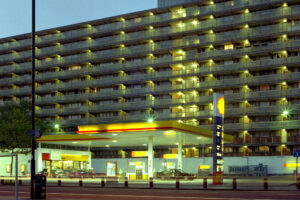Maybe the best-known fact about Thamesmead is that, in 1971, it provided the setting for one of the most memorable scenes of Stanley Kubrick’s film, A Clockwork Orange. Alex DeLarge (played by Malcolm McDowell) is shown walking along Binsey Walk and then suddenly attacking his fellow gang members. Southmere Lake and its Brutalist towers are the backdrop while the strains of Rossini’s overture La gazza ladra [The Thieving Magpie] play in the background. In 2022, speaking to Property Week, Kubrick’s American filmographer Alison Castle offered what is probably the most common contemporary understanding of that scene: “Kubrick’s choice of Thamesmead showed a very prescient instinct for how this architecture was deeply misguided and even hostile, doomed to fail as a model for living. As modernist as the buildings were, I believe he saw in them a dystopia.”
She was reiterating an all-too-common contempt for other Sixties estates. But John Grindrod, Britain’s foremost chronicler of post-war modernism, saw something very different in that scene: “The town’s formal beauty, lakes and crisp white architecture were enhanced by his use of classical music to makes the scenes of sudden violence even more shocking and incongruous.” In the early Seventies, Thamesmead still seemed futuristic, utopian even — “the town of tomorrow”, as it was dubbed when the Greater London Council embarked upon the “Woolwich-Erith Project” in 1966. The practical intention, in the Council’s words, was to “create a reservoir of housing for decanting population from the hard-pressed inner area”. In an era of mass slum clearance, the form of its early implementation was exhilarating.
These two senses of Thamesmead — coexisting interpretations of it as dystopian and utopian — are now in open warfare against each other. The social housing provider Peabody has unveiled a proposal to demolish the Lesnes Estate, an area of almost 600 homes located just to the south of Southmere Lake. However, residents are fighting to save the estate, protesting against both the loss of their own homes and the nature of their proposed replacement. Beyond this David-and-Goliath struggle, though, their conflict is a microcosm of a broader battle in British social housing: one which pits developers’ ambitions to radically redevelop estates against both the interests of those who live in them and the model of communal living they symbolise.
Here, the chief protagonist — they certainly wouldn’t consider themselves the villain of the piece — is Peabody, one of our largest social housing providers and the organisation that was seen to be coming to the rescue of Thamesmead when it took over its management back in 2014. By then, the Thamesmead project was widely judged to have failed. Its population stood at 32,000, around half of the 60,000 originally planned. The new town seemed remote and forlorn; to some, most pejoratively, even a kind of giant “sink estate” inhabited by people housed from waiting lists lacking the choice or opportunity to live somewhere better.
This was a sad betrayal of the visionary planning that had inspired Thamesmead’s early construction. The difficult site prone to flooding was treated as a chance to create water features; Southmere Lake, for example, provided drainage as well as recreation. There was even talk of “being able to travel by punt right across the site along four and a half miles of canals”. The first-floor walkways, “streets in the sky”, and ground-floor garaging of the Lesnes Estate blocks in the first phase South Thamesmead’s development reflected this location too, but also the contemporary planning ideal that cars and people should be separated for what seemed obvious reasons of health and safety.
What still excites, however, is the form of the 1,500 homes built around Southmere Lake in this phase of construction. Four 13-storey towers line the southern edge of the lake adjacent to a (since demolished) ziggurat-style, half-mile long spinal block along Binsey Walk and Coralline Walk, forming a barrier between its eastern shore and the arterial A2401, all constructed in the gleaming white concrete panels of the Balency system of prefabrication. The artists’ impressions and early photographs of Thamesmead would surely turn the head of even the most hardened traditionalist. So, what went wrong?
The conventional explanation for Thameside’s failure is straightforward. The new town was isolated by the abandonment of projected transport connections to Greater London via an extension to the Jubilee Line and a new river crossing. The failure to provide facilities within the scheme was equally damaging: the first residents moved in 1968, the first school in the same year and the health centre two years later — but incredibly the first shops not till 1971. Momentum faltered and decline set in. In any case, later phases pursued a far more conventionally suburban pattern of design and construction though possibly one better fitted to popular tastes.
Thamesmead suffered a confused period of governance after Margaret Thatcher’s abolition of the Greater London Council in 1986 until the promised revival of Peabody’s takeover in 2014. Its “plan for Thamesmead [was] simple — to create an amazing place that people love to work in, to visit, and of course, call home”. It’s hard to take issue with that — but how has it done? The most significant and positive change has been the arrival at Abbey Wood in 2022 of the Elizabeth Line, reducing the time taken to travel to central London to a mere 30 minutes. There’s also serious talk of a DLR connection from Beckton to Thamesmead itself. “This southeast London estate is the buzzing next neighbourhood to be,” Metro gushed in September 2023.
Since one of its oft-stated aims is “the creation of a more mixed community at South Thamesmead”, this must have been music to the ear of Peabody. But, as always, the devil is in the detail and implementation. What does that “more mixed community” look like in the context of plans to demolish the Lesnes Estate? It means the construction of 1,849 homes to replace the 596 to be cleared. It means directly the replacement of 411 social and “affordable” rent homes with 368 of which 307 are to be let at “London Affordable Rent” and just 61 (intended for existing residents who wish to remain) at social rent.
Peabody makes three principal claims to reflect its sensitivity to this issue. Firstly, that the floor space dedicated to affordable housing is greater in the new scheme than in the existing estate. Secondly, in a dubious stretching of the term “affordable”, that it will additionally be providing 279 homes for shared ownership. For all this pleading, the officers of the Greater London Authority concluded that the scheme failed to comply with the London Plan and resulted “in a loss of affordable housing when assessed on a per unit and per habitable room basis”.
Thirdly, and most disingenuously, Peabody suggests that residents have approved the scheme. In March 2020, 70% of residents approved (in a ballot in which two-thirds voted) the following statement: “Are you in favour of Peabody’s proposal to include Lesnes Estate in their regeneration plans for South Thamesmead?” The glossy leaflet advertising the vote urged residents to “Please read” and to “not throw away, your estate, your future”. The words “demolish”, or “demolition”, were conspicuously absent, however.
That this was not by any means a vote for the current proposals is made clear by the protests that have erupted in recent weeks. Many residents, particularly those who have already bought their houses, are up in arms, complaining about the loss of homes in which they have invested so much, and the inadequate compensation offered to enable them to purchase elsewhere. The words of Dolorosa Buhari, 69, summarise their anger: “Most of us here are retired and we have worked our lives to pay and to say ‘this is our home’, and then Peabody come in to tell us we cannot live here and they want to take our property, offering peanuts.”
The protest has also drawn the support of a wide range of housing activists opposed to the form of council -state regeneration in recent years — a familiar tale of “densification” in which developers build significantly more “units” (I’ll use the jargon for once) and yet contrive a net loss of social rent housing; in which profits accrued by the sale of homes for purchase or private rental all too frequently fail to benefit existing residents, let alone the 300,000 households on social housing waiting lists in London and the 170,000 (half of them children) living in temporary accommodation. Peabody will resent the banners proclaiming “Housing for Need not Greed” but they resonate strongly for the many displaced by estate regeneration.
Finally, at a time of climate crisis, should we really demolishing buildings — with all the loss of embodied carbon entailed — that could be effectively retrofitted to meet current environmental standards? Peabody have referred to the “poor quality and dated appearance” of the current estate but residents testify to its comfort and structural soundness.
If the climate crisis offers a new challenge, the need to house all our people well remains a persistent one. Thamesmead reflects part of the ambitious attempt to meet that challenge after 1945; one element of a national programme that built on average 126,000 social rent homes annually between 1945 and 1979 and which provided what Conservative prime minister Theresa May called, in a 2018 speech to the National Housing Federation, the “biggest collective leap in living standards in British history”.
At Thamesmead, there were obvious and avoidable planning missteps that undermined its potential, but it has suffered equally from the perfect storm of circumstances that have undermined and marginalised social housing more broadly in recent decades. The statutory right to social housing given in 1977 to those in “priority need” was a well-intentioned and progressive measure. However, in a subsequent era when social housing stock was sharply reduced by Right to Buy (well over 300,000 social rent homes have been lost in London alone) and the near cessation of new-builds, it has led to what sociologists call the “residualisation” of social housing — the perception that it is, sometimes the belief that it should be, housing of last resort.
It has never been that to the millions who have benefitted from the decent, secure and affordable homes it has offered; it is not that now to the many in desperate housing need. We must build a new generation of social rent homes supported by direct public investment — expenditure that by every rational calculation saves far money in the long-term than it costs in the short-term. We need more homes and we need more social housing. The plans and protests at the Lesnes Estate illustrate precisely why the former should not be achieved at the expense of the latter.
Disclaimer
Some of the posts we share are controversial and we do not necessarily agree with them in the whole extend. Sometimes we agree with the content or part of it but we do not agree with the narration or language. Nevertheless we find them somehow interesting, valuable and/or informative or we share them, because we strongly believe in freedom of speech, free press and journalism. We strongly encourage you to have a critical approach to all the content, do your own research and analysis to build your own opinion.
We would be glad to have your feedback.
Source: UnHerd Read the original article here: https://unherd.com/



